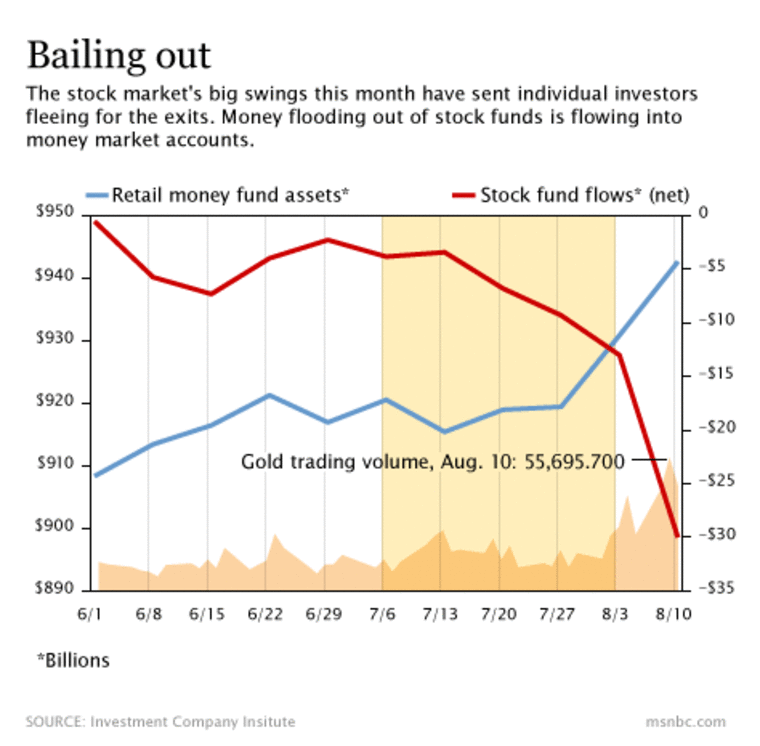If the recent wild leaps and plunges in financial markets have prompted you to cash out your stocks, you’re not alone. Individual investors are bolting for the exits.
Thursday's big sell-off, which saw the Dow Jones industrial average move by triple digits for the ninth time this month, was the latest evidence of a crisis mentality that has taken hold on global financial markets, turning the usually quiet month of August into a nail-biter for small investors. A lot them have just one word for their broker: “Sell.”
“You're talking about money exiting the market en masse and it's completely wanting to get out stocks agnostic of sector,” said Art Hogan, a managing director at Lazard Capital Markets. “What we're having right now is panic selling.”
The stampede began this month, following the spectacle of a U.S. Congress pushing the country to the brink of self-induced default. Since then, the flood of money out of stocks has accelerated as investors fret about European banks shaken by a debt crisis, a political stalemate in Washington and fears of another recession.
Terrified investors yanked more than $40 billion out of stock and bond funds in the week ended Aug. 10, the latest data available from the Investment Company Institute, the mutual fund industry’s trade group. That was the biggest mutual fund cash-out since mid-October 2008, when investors panicked following the collapse of Lehman Bros. and the virtual shutdown of the credit markets.
For now, much of the money being pulled out of stocks is flooding into money market accounts, which have swollen by more then $34 billion in the past few weeks. Nervous investors have also bid up the price of gold to a record of more than $1,800 an ounce.
Last week, trading in one popular fund that invests in gold surged to 55 million shares in a single day, more than three times the average daily volume so far this year. Since July 1, the price of gold has surged 23 percent.

For many investors, fears are fresh of the stock market collapse that followed the 2008 financial meltdown, when the Dow fell more than 30 percent in less than six months. With Europe’s banks bracing for fallout from the euro zone’s debt crisis, investors fear another “Lehman moment,” when problems at one bank sparked a panic that spread rapidly throughout the system.
“There's a great possibility, I think, of that happening,” said Harvey Miller, an attorney at Weil, Gotshal & Manges who is working on the Lehman bankruptcy. “I think there's a lot of fear in the economy today, and fear causes people to panic.”
The market’s gyrations have been amplified by the trend in recent years to turn stock trading over to computers. In the past, so-called “market makers” on major stock exchanges kept a damper on big price moves by stepping in as the buyer or seller of last resort. Today, more than half of the total share volume is handled by computers that buy or sell in a fraction of a second based on complex algorithms, according to Edward Wedbush, founder and CEO of Wedbush Securities.
“The dynamics on the downside are much more vigorous and quicker,” he said. “So the market will go down a lot more rapidly than go up.”
Those computers still work for human investors, though, and those investors don’t like the latest headlines on the global economic outlook. As the latest data continue to point to a slowing economy, forecasters have been writing down their predictions for the second half of the year.
The latest came from Morgan Stanley economists Thursday, who cited the increased risk of U.S. recession when they marked down their forecast for global growth. Traders also dumped shares following Thursday’s reports of another drop in home sales and weakness in the manufacturing sector, one of the few bright spot in a weak recovery.
Beyond the political gridlock in Washington, the Federal Reserve appears increasingly powerless to use its traditional monetary policy tools to revive growth. The central bank has already forced short-term rates close to zero; investors snapping up U.S. Treasury bonds as a safe haven have pushed long-term interest rates below 2 percent to levels not seen since the end of World War II.
Cheap credit has failed to revive growth. Gross domestic product grew less than 1 percent in the first half of the year, a “stall speed” that many economists warn increases the risk of another recession. But with the cost of borrowing already at historic lows, it’s not clear what the Federal Reserve can do to get the economy growing fast enough to create more jobs and revive consumer and investor confidence.
“Whether it is an official decline (in growth) and contraction in GDP or where it is 1 percent growth, it is still going to feel the same,” said Peter Boockvar, a market strategist at Miller Tabak. “We have reached the law of diminishing returns with respect to Fed policy and easy money.
With monetary policy options limited, fiscal stimulus — the use of tax and spending policy to revive growth — is the only other tool available to the government. President Barack Obama has promised to announce a new jobs plan soon, but deep partisan gridlock make any major stimulus spending unlikely.
If the economy is, indeed, slipping into recession there appears to be little the government can do to prevent it.
Last week brought fresh evidence that the threat of recession is spreading beyond the U.S. as growth in Europe slowed to a virtual standstill in the latest quarter. But Europe’s political leaders appear equally deadlocked, and central bankers powerless, to arrive at solutions.
“The optimistic forecast is very bad,” said former Federal Reserve governor Laurence Meyer, who is now a private economist. “The pessimistic forecast is virtually catastrophic given that there are limited tools to respond if we fall into to a global recession.”